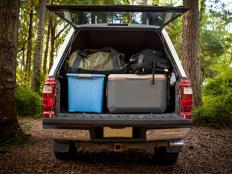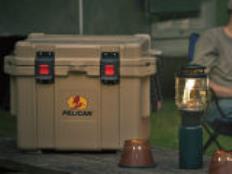
You've finally made it to the campground. But before you can run off to the lake or go for a hike, the first order of the day is to park and level your RV so that your refrigerator will operate properly and you don't find yourself in bed at night with your feet higher than your head.
Never assume your site will be flat or level. That would make parking an RV too easy. Due to the nature of camping, chances are higher that your site will be rutted, gouged and somewhat uneven.
But don't fret. You can still get your RV into your spot, and leveled so it operates properly, with a few easy steps. Here's how:
How to Park an RV
With many campsites designed to accommodate smaller vehicles, easing your 30-foot long fifth-wheeler or even longer motorhome into some spots can be a challenge.
That's why it's important to:
- Verify that your RV can get to your campsite. While the roads in most campgrounds are easy to navigate, there are still some that could be difficult to access due to hairpin turns and tight squeezes among boulders and trees. Some camping websites post caution notices to warn owners of longer rigs that they might want to consider another campground. If such warnings don't appear on the website and you have concerns, contact the campground directly and ask.
- Make sure your rig will fit the campsite. Most campground reservation websites provide details for each site, including its length. Check that the spot you've selected will accommodate both your tow vehicle and your trailer, or your motorhome, without sticking out into the road. Some reservation sites will also indicate low hanging tree branches or other obstructions.
- Check the campsite before you pull in. If you can do so without blocking traffic, get out and look the spot over. Scope out any objects or terrain that might pose hazards, such as drainage ditches, roadside markers, low hanging branches, posts, and power and water hookups. These same obstacles can prevent you from extending slide outs, so make sure you have clearance. Also, check to see if there are any especially low spots in the site that you'll want to avoid.
- Have an assistant guide you in. No matter how skilled you think you are at backing into campsites, things will go a lot smoother with extra eyes watching. There's nothing worse than the embarrassing crunch of an RV bumper kissing a large rock or a picnic table. Your helper can also make sure you've got the rig in straight and that you're completely out of the road. For easier communication, get yourself a pair of two-way radios so you and your assistant won't have to yell.
How to Level an RV
There are several reasons to make sure your RV is level, including proper refrigerator operation and safe slide out extension (if you have them). You'll also want to stabilize your rig so that it doesn't sway when you move about inside or in windy conditions.
Many luxury motorhomes and trailers come equipped with exotic self-leveling systems, with hydraulic or electric rams that extend at the touch of a button and level the coach automatically. For rigs without this nicety, leveling blocks or ramps and a small bubble level are required.
Leveling blocks or ramps don't have to be expensive. They can be as simple as a stack of 2x10-inch boards. Or, you can step up to interlocking RV leveling blocks. Made of high-strength plastic, these blocks are touted as being able to bear the weight of even the largest motorhomes and trailers.
- 1
- of
- 2








Discuss This Article